Multilayer-Forming Behavior of Cr Nitrides and Carbides for Thermoreactive Deposition
Abstract
1. Introduction
2. Experimental Details
3. Results and Discussion
3.1. Microstructure and Crystal Structure of the Coating Layer
3.1.1. Plasma-Nitrided Layer
3.1.2. Thermoreactive Deposited Layer
3.2. Formation Behavior of the Coating Layer with Respect to Temperature
3.3. Formation Behavior of Coating Layers with Respect to the TRD Time at 950 °C
3.4. Diffusion of Fe, Cr, C, and N During the Formation of Coating Layers
4. Conclusions
- (1)
- In the direct-TRD process, a coating layer of ~4 μm thickness was formed at 950 °C. Mostly, a Cr7C3 layer was formed and a small amount of CrN phase formed.
- (2)
- The PN-TRD process showed a faster coating layer formation rate than the direct-TRD process, and a coating layer of ~7 μm thickness was formed at 950 °C. When the TRD temperature was increased to 800 °C, the rich N supplied from the decomposition of Fe2-3N and the Cr supplied from the TRD powder reacted to produce the CrN layer with a thickness of 2 μm. The outermost surface layer consisted of a mixed (Cr7C3 + CrN) layer. Furthermore, a C-rich zone was formed under the CrN layer.
- (3)
- When the TRD temperature was increased to 950 °C, a 2 μm-thick Cr7C3 layer was formed between the (Cr7C3 + CrN) layer, and the CrN layer formed at the interface between the base material and the coating layer. The whole composite layer consisted of (Cr7C3 + CrN)–Cr7C3–CrN and had a thickness of ~7 μm.
- (4)
- For the 950 °C 6 h specimen, the coating layer had the same elemental distribution as that of the 3 h specimen and the thickness of 10–12 μm. However, the multilayer and interface were concretely filled without the formation of voids as the TRD time increased to 6 h at 950 °C. The TRD process on the pre-nitrided layer was successfully applied to produce a multilayer of (CrN + Cr7C3)–Cr7C3–CrN–(Cr, Fe)7C3 from the outermost layer.
Author Contributions
Acknowledgments
Conflicts of Interest
References
- Oil and Colour Chemists’ Association, Raw Materials and Their Usage. In Surface Coatings; Springer: Dordrecht, The Netherlands, 2012; Volume 1, ISBN 9789401045346.
- Warcholinski, B.; Gilewicz, A. Tribological properties of CrNx coatings. J. Achiev. Mater. Manuf. Eng. 2009, 37, 498–504. [Google Scholar]
- Maury, F.; Douard, A.; Delclos, S.; Samelor, D.; Tendero, C. Multilayer chromium based coatings grown by atmospheric pressure direct liquid. Surf. Coat. Technol. 2009, 204, 983–987. [Google Scholar] [CrossRef]
- Aghaie-Khafri, M.; Fazlalipour, F. Vanadium carbide coatings on die steel deposited by the thermo-reactive diffusion technique. J. Phys. Chem. Sol. 2008, 69, 2465–2470. [Google Scholar] [CrossRef]
- Binder, C.; Bendo, T.; Hammes, G.; Klein, A.N.; de Mello, J.D.B. Effect of Nature of Nitride Phases on Sliding Wear of Plasma Nitrided Sintered Iron. Wear 2015, 332–333, 995–1005. [Google Scholar] [CrossRef]
- Hakami, F.; Sohi, M.H.; Ghani, J.R.; Ebrahimi, M. Chromizing of plasma nitrided AISI 1045 steel. Thin Solid Films 2011, 519, 6783–6786. [Google Scholar] [CrossRef]
- Hakami, F.; Sohi, M.H.; Ghani, J.R. Duplex surface treatment of AISI 1045 steel via plasma nitriding of chromized layer. Thin Solid Films 2011, 519, 6792–6796. [Google Scholar] [CrossRef]
- Taktak, S.; Ulker, S.; Gunes, I. High temperature wear and friction properties of duplex surface treated bearing steels. Surf. Coat. Technol. 2008, 202, 3367–3377. [Google Scholar] [CrossRef]
- Wei, C.Y.; Chen, F.S. Characterization on multi-layer fabricated by TRD and plasma nitriding. Mater. Chem. Phys. 2005, 90, 178–184. [Google Scholar] [CrossRef]
- Cao, H.L.; Luo, C.P.; Liu, J.W.; Zou, G.F. Phase transformations in low-temperature chromized 0.45wt% C plain carbon steel. Surf. Coat. Technol. 2007, 201, 7970–7977. [Google Scholar] [CrossRef]
- Gilewicz, A.; Warcholinski, B. Tribological properties of CrCN/CrN multilayer coatings. Tribol. Int. 2014, 80, 34–40. [Google Scholar] [CrossRef]
- Warcholinski, B.; Gilewicz, A. The properties of multilayer CrCN/CrN coatings dependent on their architecture Plasma Process. Plasma Process. Polym. 2011, 8, 333–339. [Google Scholar] [CrossRef]
- Hirsch, T.; Clarke, T.G.R.; da Silva Rocha, A. An in-situ study of plasma nitriding. Surf. Coat. Technol. 2007, 201, 6380. [Google Scholar] [CrossRef]
- Clarke, T.G.R.; da Silva Rocha, A.; Reguly, A.; Hirsch, T. In situ XRD measurements during plasma nitriding of a medium carbon steel. Surf. Coat. Technol. 2005, 194, 283. [Google Scholar] [CrossRef]
- Lee, K.; Kang, N.; Bae, J.; Lee, C.W. Microstructural behavior of nitriding compound layer for Nb-carbonitride coating grown by thermo-reactive diffusion process. Met. Mater. Int. 2016, 22, 842–848. [Google Scholar] [CrossRef]
- Arai, T. Thermo-Reactive Deposition/Diffusion Process ASM Handbook: Heat Treating; ASM International: Materials Park, OH, USA, 1991; Volume 4. [Google Scholar]
- Ozdemira, O.; Sen, S.; Sen, U. Formation of chromium nitride layers on AISI 1010 steel by nitro-chromizing treatment. Vacuum 2007, 81, 567–870. [Google Scholar] [CrossRef]
- Aghaie-Khafri, M.; Fazlalipour, F.; Phys, J. Kinetics of V(N,C) coating produced by a duplex surface treatment. Chem. Solids 2008, 69, 2465. [Google Scholar] [CrossRef]
- Wei, C.Y.; Chen, F.S. Thermoreactive deposition coating of chromium carbide by contact free method. Mater. Chem. Phys. 2005, 91, 192–199. [Google Scholar] [CrossRef]
- Chen, F.S.; Lee, P.Y.; Yeh, M.C. Thermal reactive deposition coating of chromium carbide on die steel in a fluidized bed furnace. Mater. Chem. Phys. 1998, 53, 19–27. [Google Scholar] [CrossRef]
- Lu, X.J.; Xiang, Z.D. Formation of chromium nitride coatings on carbon steels by pack cementation process. Surf. Coat. Technol. 2017, 309, 994–1000. [Google Scholar] [CrossRef]
- King, P.C.; Reynoldson, R.W.; Brownrigg, A.; Long, J.M. Cr(N,C) diffusion coating formation on pre-nitrocarburised H13 tool steel. Surf. Coat. Technol. 2004, 179, 18–26. [Google Scholar] [CrossRef]
- Lee, J.W.; Duh, J.G. Evaluation of microstructures and mechanical properties of chromized steels with different carbon contents. Surf. Coat. Technol. 2004, 177–178, 525. [Google Scholar] [CrossRef]
- Taktak, S.; Gunes, I.; Ulker, S.; Yalcin, Y. Effect of N2+H2 gas mixtures in plasma nitriding on tribological properties of duplex surface treated steels. Mater Charact. 2008, 59, 1784. [Google Scholar] [CrossRef]
- Ghahfarokhi, H.H.; Saatchi, A.; Monirvaghefi, S.M. Corrosion investigation of chromium nitride and chromium carbide coatings for PEM fuel cell bipolar plates in simulated cathode condition. Fuel Cells 2016, 16, 356. [Google Scholar] [CrossRef]
- Cullity, B.D.; Stock, S.R. Elements of X-ray Diffraction, 3rd ed.; Prentice-Hall: New York, NY, USA, 2001; ISBN 9780201610918. [Google Scholar]
- Dossett, J.; Totten, G.E. Fundamentals of nitriding and nitrocarburizing. In ASM Handbook: Steel Heat Treating Fundamentals and Processes; ASM International: Materials Park, OH, USA, 2013; p. 619. ISBN 9781627080118. [Google Scholar]
- Cao, H.L.; Luo, C.P.; Liu, J.W.; Wu, C.L.; Zou, G.F. Formation of a nanostructured CrN layer on nitrided tool steel by low temperature chromizing. Scr. Mater. 2008, 58, 786. [Google Scholar] [CrossRef]
- King, P.C.; Reynoldson, R.W.; Brownrigg, A.; Long, J.L. Fluidized bed CrN coating formation on prenitrocarburized plain carbon steel. J. Mater. Eng. Perform. 2004, 13, 431. [Google Scholar] [CrossRef]
- Baggio-Scheid, V.H.; de Vasconcelos, G.; Oliveira, M.A.S.; Ferreira, B.C. Duplex surface treatment of chromium pack diffusion and plasma nitriding of mild steel. Surf. Coat. Technol. 2003, 163–164, 313–317. [Google Scholar] [CrossRef]
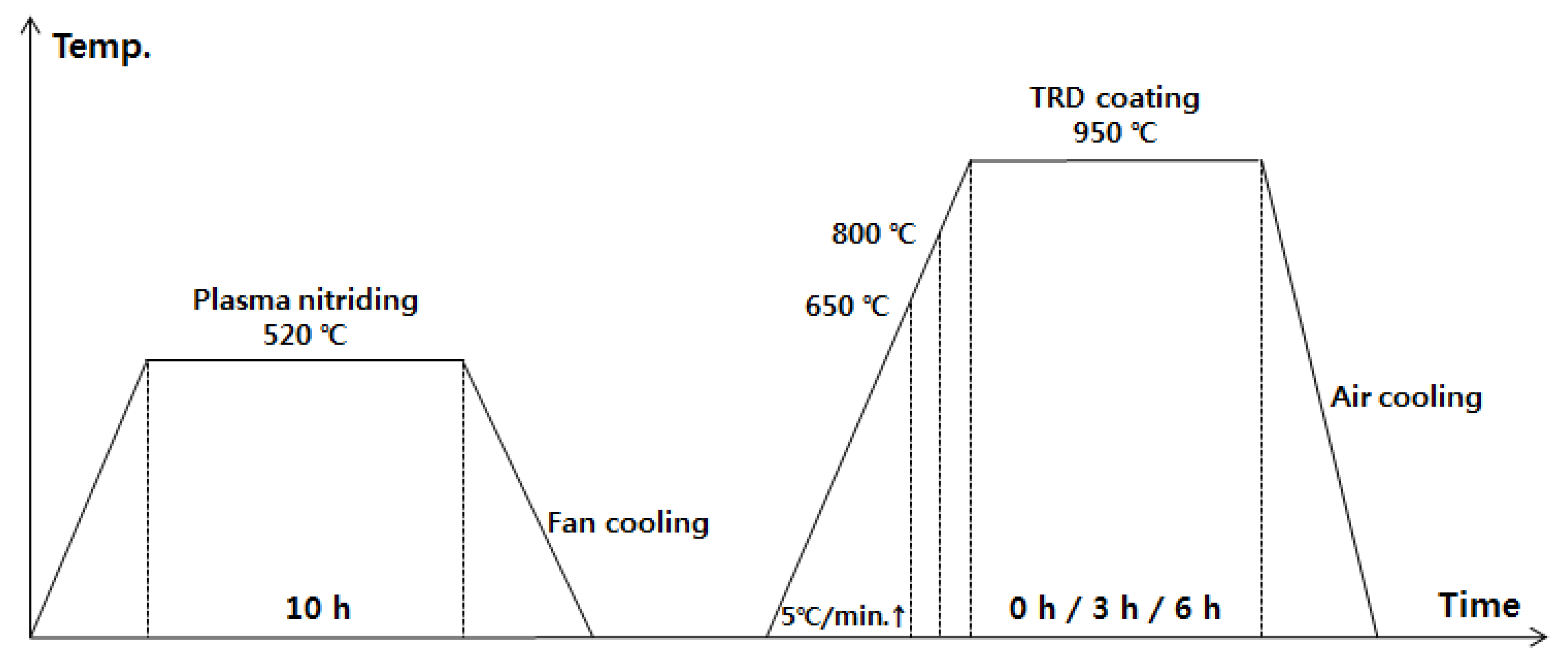
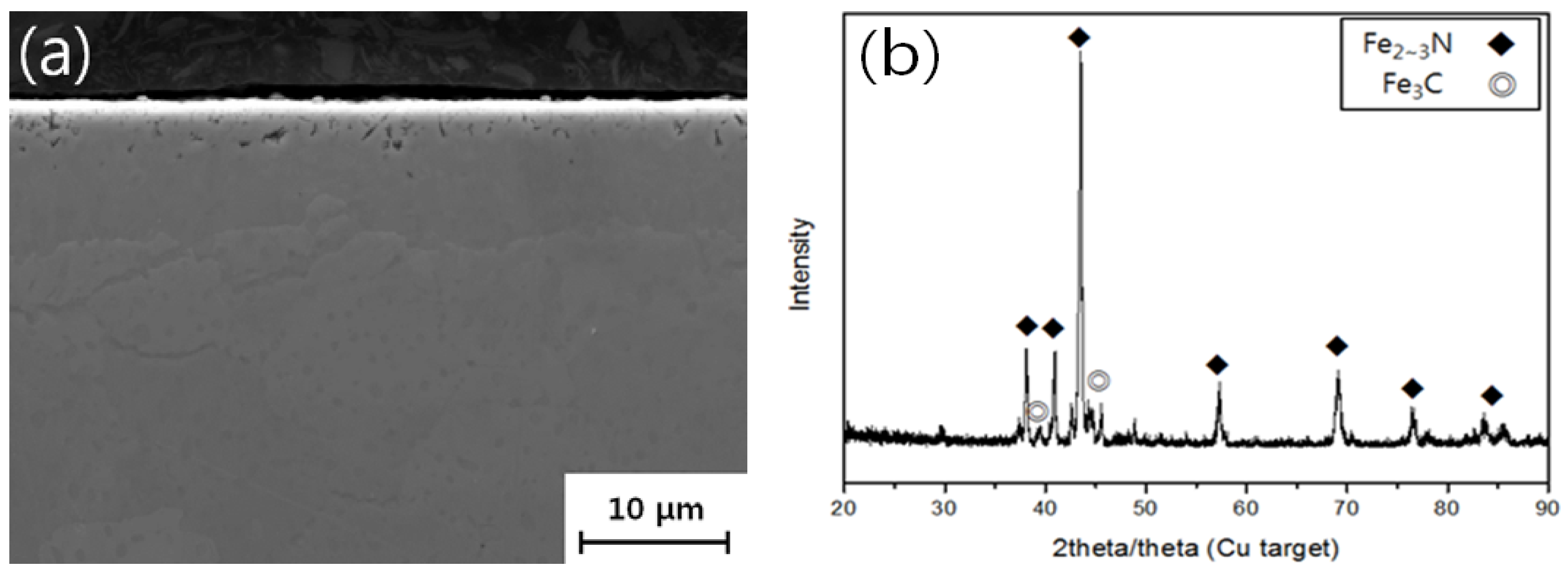
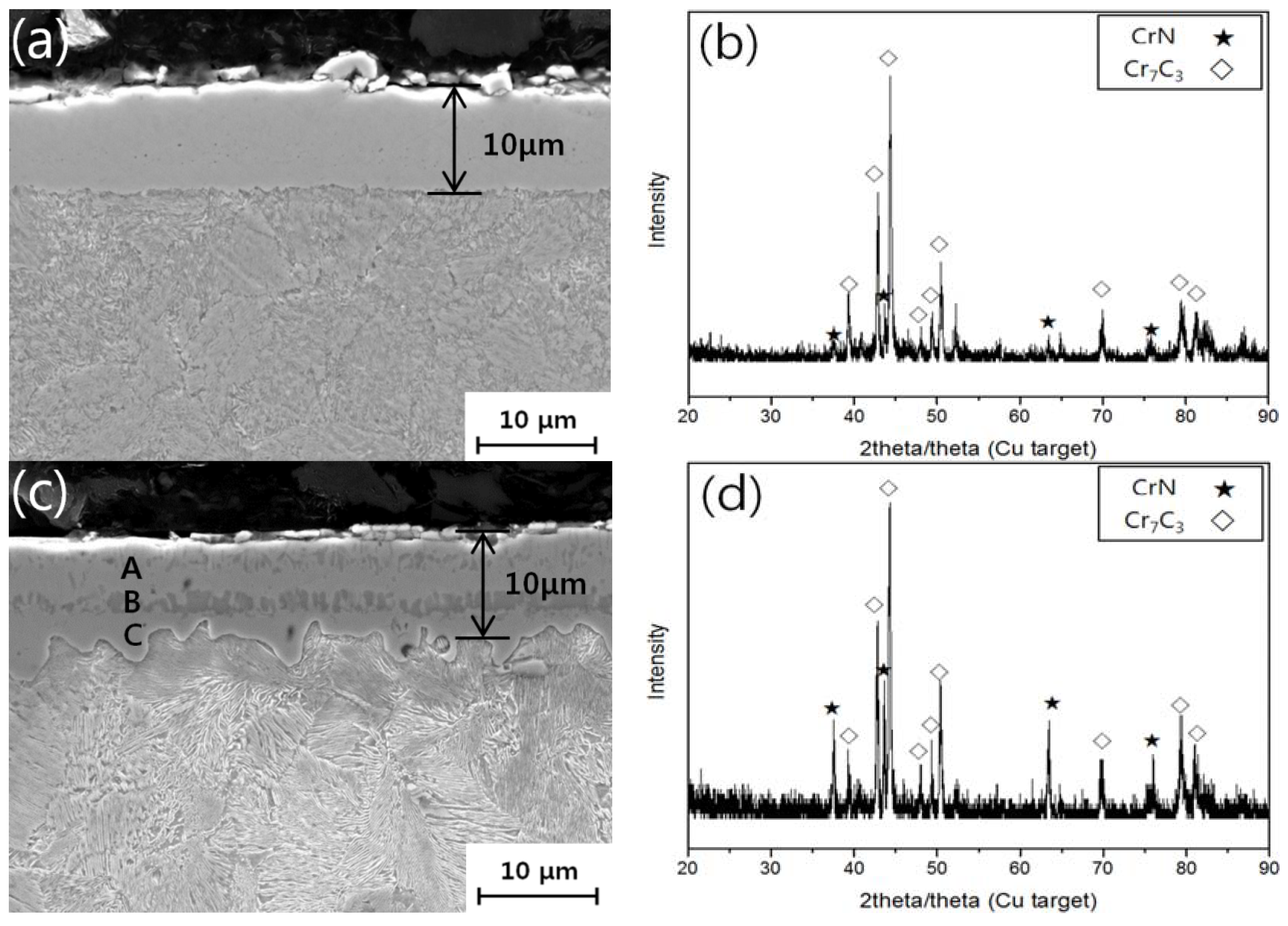

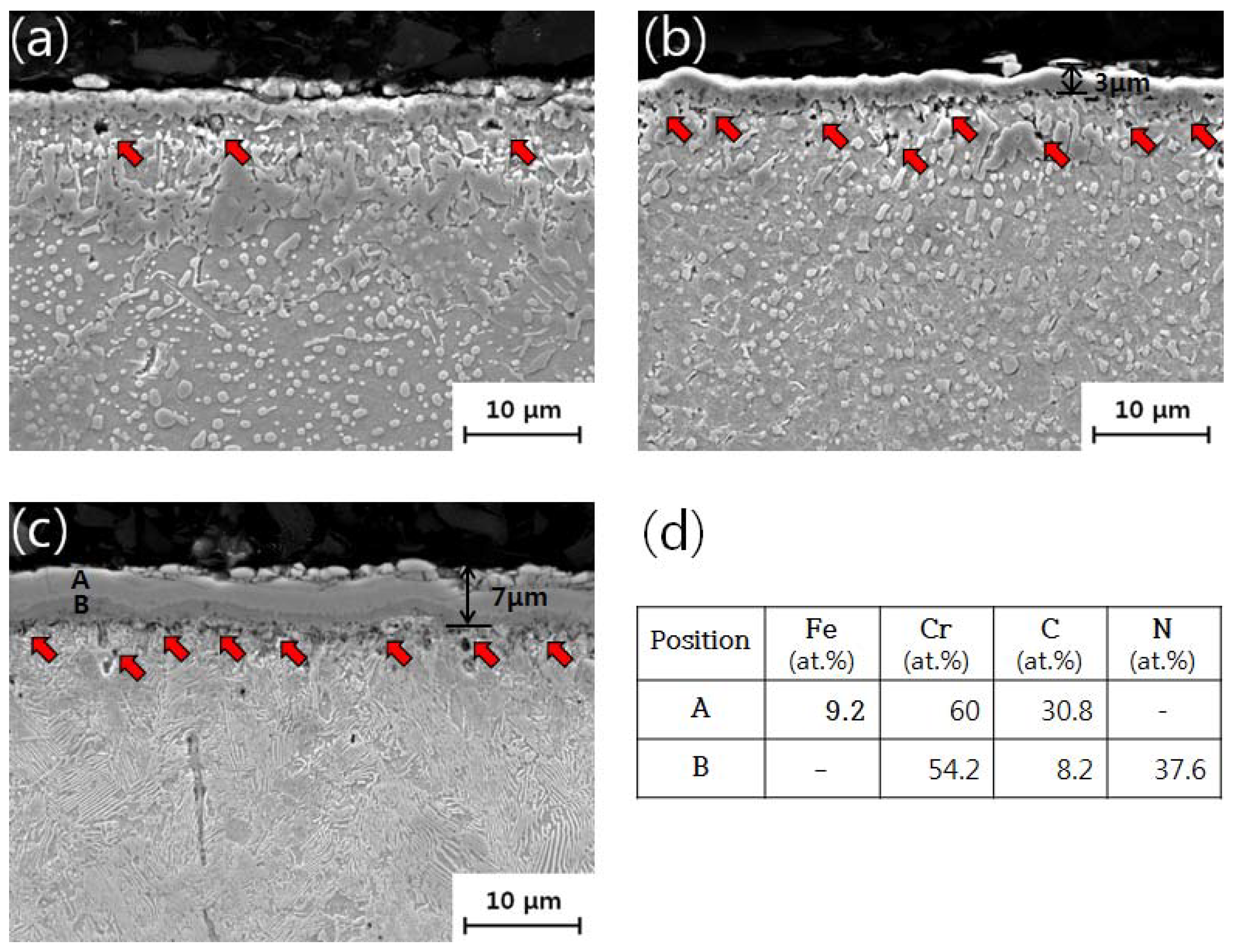
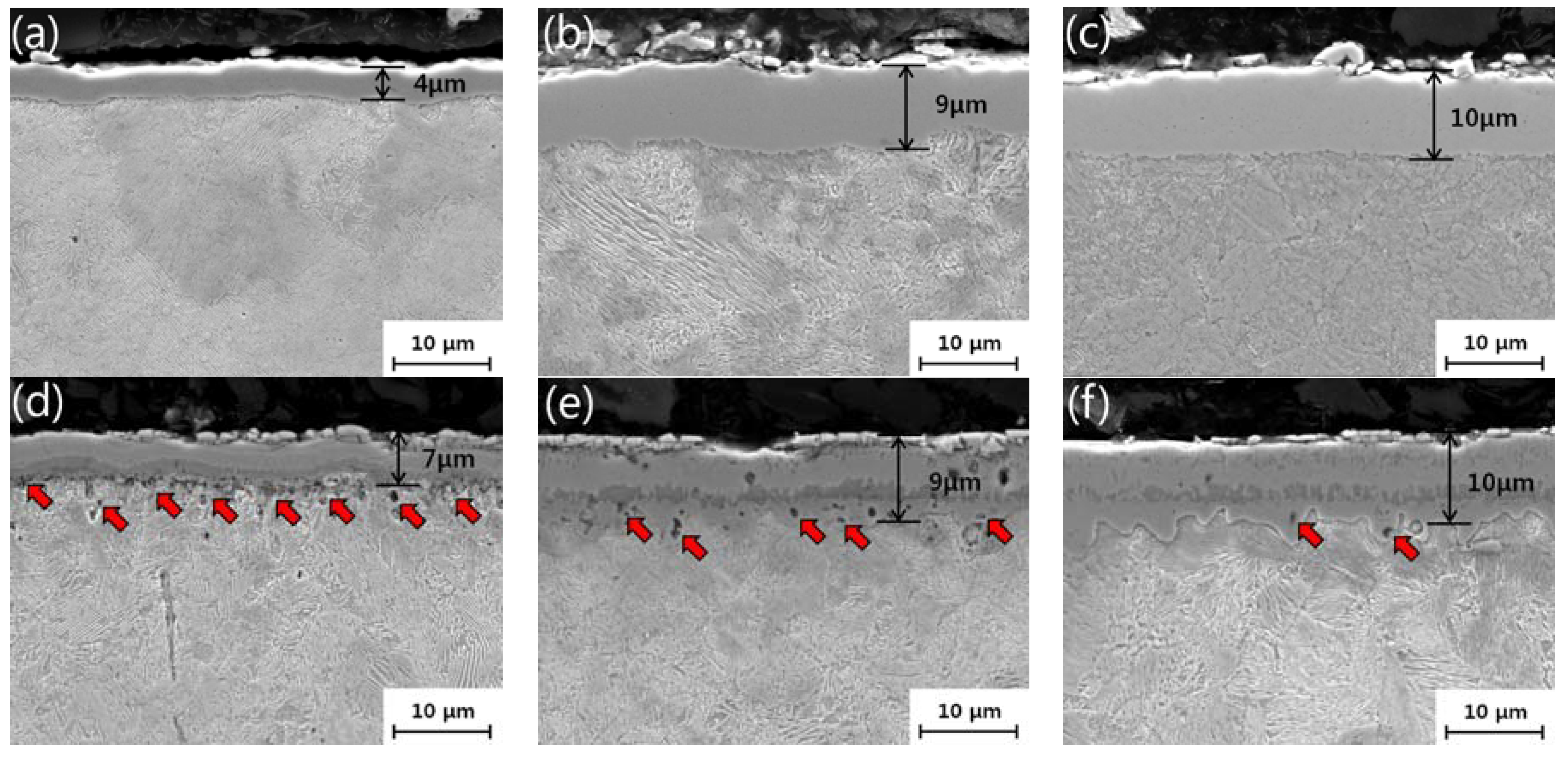
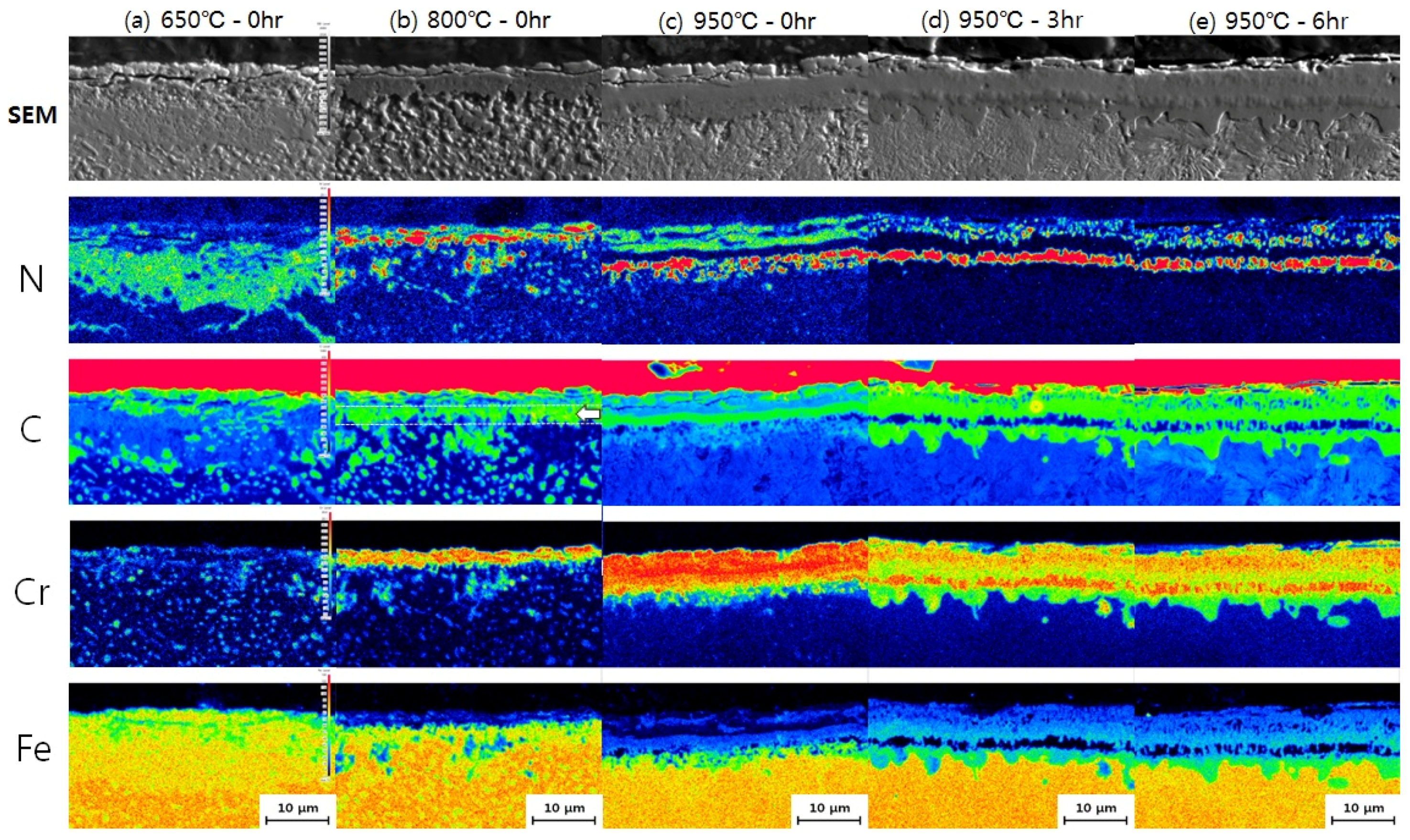
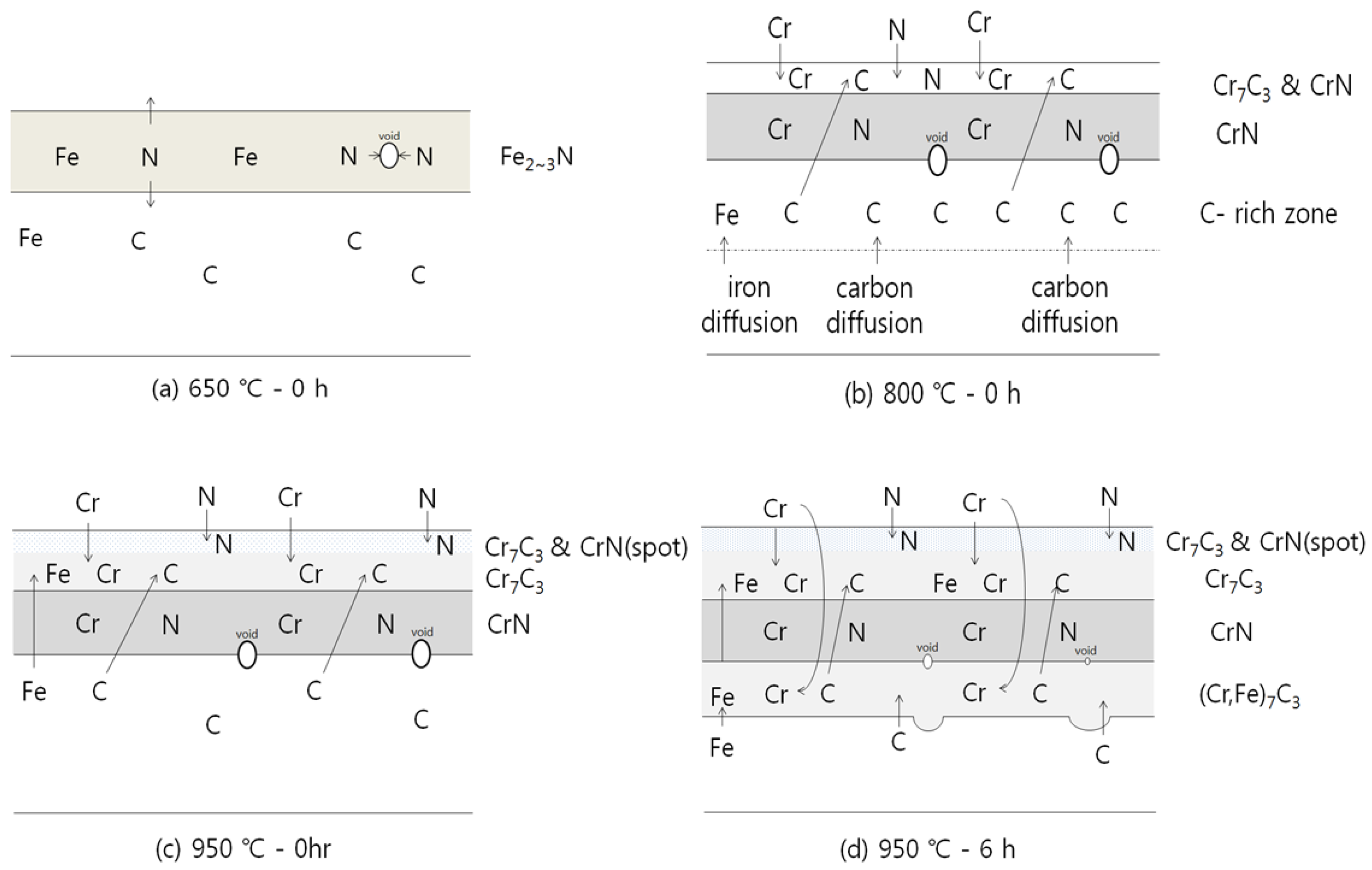
| Element | C | Cr | Mn | Si | P | S | Cu | Ni | Mo | Fe |
|---|---|---|---|---|---|---|---|---|---|---|
| wt % | 0.95 | 1.39 | 0.4 | 0.31 | 0.08 | 0.05 | 0.12 | 0.08 | 0.03 | Balanced |
| Position | Fe (at %) | Cr (at %) | C (at %) | N (at %) |
|---|---|---|---|---|
| A | 26.8 | 42.7 | 30.5 | - |
| B | 0.6 | 55.4 | 5.6 | 38.4 |
| C | 39.7 | 29.3 | 31.0 | - |
© 2018 by the authors. Licensee MDPI, Basel, Switzerland. This article is an open access article distributed under the terms and conditions of the Creative Commons Attribution (CC BY) license (http://creativecommons.org/licenses/by/4.0/).
Share and Cite
Park, K.; Kim, J.-H.; Kim, S.; Kang, N. Multilayer-Forming Behavior of Cr Nitrides and Carbides for Thermoreactive Deposition. Metals 2018, 8, 400. https://doi.org/10.3390/met8060400
Park K, Kim J-H, Kim S, Kang N. Multilayer-Forming Behavior of Cr Nitrides and Carbides for Thermoreactive Deposition. Metals. 2018; 8(6):400. https://doi.org/10.3390/met8060400
Chicago/Turabian StylePark, Kyeongmo, Jun-Ho Kim, Sunkwang Kim, and Namhyun Kang. 2018. "Multilayer-Forming Behavior of Cr Nitrides and Carbides for Thermoreactive Deposition" Metals 8, no. 6: 400. https://doi.org/10.3390/met8060400
APA StylePark, K., Kim, J.-H., Kim, S., & Kang, N. (2018). Multilayer-Forming Behavior of Cr Nitrides and Carbides for Thermoreactive Deposition. Metals, 8(6), 400. https://doi.org/10.3390/met8060400






